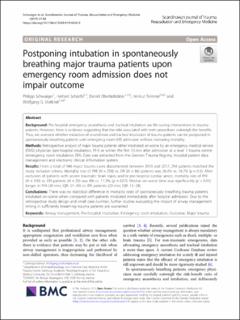| dc.contributor.author | Schwaiger, Philipp | |
| dc.contributor.author | Schöchl, Herbert | |
| dc.contributor.author | Oberladstätter, Daniel | |
| dc.contributor.author | Trimmel, Helmut | |
| dc.contributor.author | Voelckel, Wolfgang Georg Cornelius | |
| dc.date.accessioned | 2020-05-18T13:19:46Z | |
| dc.date.available | 2020-05-18T13:19:46Z | |
| dc.date.created | 2019-09-19T09:22:14Z | |
| dc.date.issued | 2019-08 | |
| dc.identifier.citation | Schwaiger, P., Schöchl, H., Oberladstätter, D. et al. (2019) Postponing intubation in spontaneously breathing major trauma patients upon emergency room admission does not impair outcome. Scandinavian Journal of Trauma, Resuscitation and Emergency Medicine, 27, 80. | en_US |
| dc.identifier.issn | 1757-7241 | |
| dc.identifier.uri | https://hdl.handle.net/11250/2654839 | |
| dc.description.abstract | Background
Pre-hospital emergency anaesthesia and tracheal intubation are life-saving interventions in trauma patients. However, there is evidence suggesting that the risks associated with both procedures outweigh the benefits. Thus, we assessed whether induction of anaesthesia and tracheal intubation of trauma patients can be postponed in spontaneously breathing patients until emergency room (ER) admission without increasing mortality.
Methods
Retrospective analysis of major trauma patients either intubated on-scene by an emergency medical service (EMS) physician (pre-hospital intubation, PHI) or within the first 10 min after admission at a level 1 trauma centre (emergency room intubation, ERI). Data was extracted from the German Trauma Registry, hospital patient data management and electronic clinical information system.
Results
From a total of 946 major trauma cases documented between 2010 and 2017, 294 patients matched the study inclusion criteria. Mortality rate of PHI (N = 258) vs. ERI (N = 36) patients was 26.4% vs. 16.7% (p = 0.3). After exclusion of patients with severe traumatic brain injury and/or pre-hospital cardiac arrest, mortality rate of PHI (N = 100) vs. ERI patients (N = 29) was 6% vs. 17.2%, (p = 0.07). Median on-scene time was significantly (p < 0.01) longer in PHI (30 min; IQR: 21–40) vs. ERI patients (20 min; IQR: 15–28).
Conclusions
There was no statistical difference in mortality rates of spontaneously breathing trauma patients intubated on-scene when compared with patients intubated immediately after hospital admission. Due to the retrospective study design and small case number, further studies evaluating the impact of airway management timing in sufficiently breathing trauma patients are warranted. | en_US |
| dc.language.iso | eng | en_US |
| dc.publisher | BioMed Central | en_US |
| dc.rights | Navngivelse 4.0 Internasjonal | * |
| dc.rights.uri | http://creativecommons.org/licenses/by/4.0/deed.no | * |
| dc.subject | akuttmedisin | en_US |
| dc.subject | intubasjon | en_US |
| dc.subject | intubering | en_US |
| dc.title | Postponing intubation in spontaneously breathing major trauma patients upon emergency room admission does not impair outcome | en_US |
| dc.type | Peer reviewed | en_US |
| dc.type | Journal article | en_US |
| dc.description.version | publishedVersion | en_US |
| dc.rights.holder | © The Author(s). 2019 | en_US |
| dc.subject.nsi | VDP::Medisinske Fag: 700::Klinisk medisinske fag: 750::Traumatologi: 783 | en_US |
| dc.source.pagenumber | 8 | en_US |
| dc.source.volume | 27 | en_US |
| dc.source.journal | Scandinavian Journal of Trauma, Resuscitation and Emergency Medicine | en_US |
| dc.identifier.doi | 10.1186/s13049-019-0656-9 | |
| dc.identifier.cristin | 1726539 | |
| cristin.ispublished | true | |
| cristin.fulltext | original | |
| cristin.qualitycode | 1 | |

